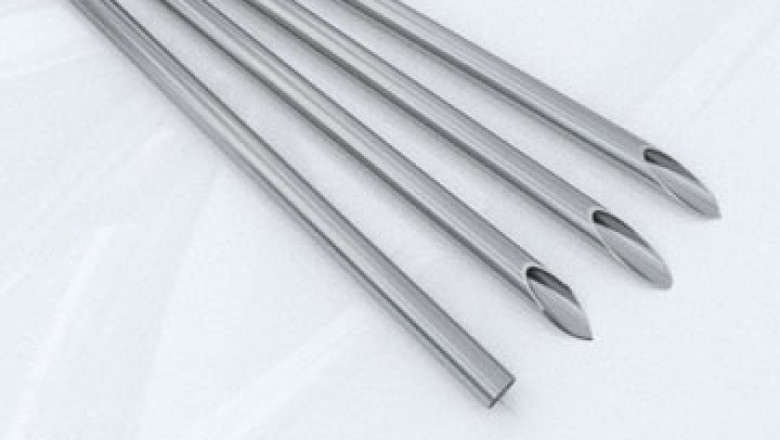views
When it comes to precision in medical, industrial, and laboratory equipment, stainless steel needle tubing plays a major role. This small but powerful tubing is used in many sensitive applications because it is durable, corrosion-resistant, and strong. Choosing the right stainless steel needle tubing may seem confusing at first, but it becomes easy when you know what to look for.
What is Stainless Steel Needle Tubing?
Stainless steel needle tubing is a type of small-diameter tube made of stainless steel. It is used in instruments that need high precision, such as medical needles, chemical injectors, catheters, and laboratory tools. The tubing is often very thin but strong, allowing liquids or gases to pass through smoothly without leaking or breaking.
It is widely used in industries such as:
-
Medical and healthcare
-
Aerospace
-
Laboratory research
-
Automotive
-
Chemical processing
-
Electronics and micro-components
Why Stainless Steel?
Stainless steel is a top choice for needle tubing because:
-
It resists rust and corrosion
-
It can handle high pressure
-
It is strong but flexible
-
It is safe for medical use
-
It maintains shape and quality over time
There are different grades of stainless steel, each with slightly different properties. Choosing the right one depends on your specific use.
Key Factors to Consider When Choosing Stainless Steel Needle Tubing
To choose the right stainless steel needle tubing, you should consider the following important points:
1. Application or Use Case
The first thing you should ask is: What will the tubing be used for?
-
For medical uses, such as syringes or catheters, the tubing must be bio-safe and extremely clean.
-
For chemical labs, it must resist corrosion from harsh substances.
-
In automotive or industrial machines, it must be strong enough to handle pressure and vibration.
Understanding your application helps you select the best tubing grade, size, and finish.
2. Material Grade
The most common grades for stainless steel needle tubing are:
-
304: General-purpose stainless steel, good corrosion resistance.
-
316: Better corrosion resistance, especially in chemical or marine environments.
-
316L: Low carbon version of 316, ideal for sensitive applications like surgery.
-
321 or 347: Used where higher temperatures are present.
Always check if the grade you choose suits your working environment.
3. Tube Size and Wall Thickness
Size is very important when selecting stainless steel needle tubing. You need to choose:
-
Outer Diameter (OD): The width of the outside of the tube.
-
Inner Diameter (ID): The width of the inside of the tube.
-
Wall Thickness: The thickness of the tube wall, which affects strength and flexibility.
Make sure the ID and OD match your device or fitting. A wrong size can cause leaks or connection issues.
4. Tolerance and Precision
In industries like medical or electronics, even a small size difference can cause a big problem. That’s why you should always look for tight tolerance tubing. Precision tubing has uniform thickness and smooth finishes to ensure consistent performance.
If your application demands very fine measurements, ask for precision tubing from your supplier.
5. Surface Finish
Some uses require a smooth inner surface to prevent blockage or allow smooth fluid flow. Medical and chemical applications often require tubing with electropolished or bright annealed surfaces.
Rough surfaces may catch particles or affect chemical reactions, so choose the finish based on what will flow through the tube.
6. Length and Form
Stainless steel needle tubing is available in various lengths—either straight-cut pieces or coils. You may need:
-
Straight tubing for fixed structures
-
Coiled tubing for flexible or movable systems
Some suppliers also offer custom cutting or pre-bent shapes to save time and effort.
7. Cleanliness and Sterilization
If your tubing is used in medical, food, or pharma industries, cleanliness is key. The tubing must be sterilized and free of oil, dust, or chemical residue.
Check if the tubing meets medical-grade or food-grade cleanliness standards, such as ASTM or ISO certifications.
8. Pressure and Temperature Requirements
Some applications involve high pressure or high heat. In these cases, make sure your stainless steel needle tubing can handle the conditions.
For example:
-
In fuel injection systems, pressure may be very high.
-
In chemical plants, temperature may rise sharply.
Always check the maximum pressure and temperature ratings for the tubing.
9. Compliance with Industry Standards
Look for tubing that complies with standards like:
-
ASTM A269
-
ASTM A213
-
ISO 9626 (for medical tubing)
-
EN standards (for European applications)
These ensure your tubing is safe, tested, and approved for specific uses.
Tips for Working with a Supplier
When ordering stainless steel needle tubing, always:
-
Share your complete specifications (grade, size, use, etc.)
-
Ask if they offer custom cutting, polishing, or bending
-
Ensure they offer quality testing reports
-
Choose a supplier that understands your industry
A reliable supplier will not only provide the right product but also guide you on what works best for your needs.
Common Applications of Stainless Steel Needle Tubing
-
Medical Devices: Needles, catheters, guide wires
-
Chemical Injection: In oil & gas or lab setups
-
Miniature Pumps: For fluid delivery systems
-
Sensors and Instruments: For flow or pressure control
-
Automotive Systems: Fuel lines or emission control
-
Aerospace: Light-weight and durable connections
Final Thoughts
Choosing the right stainless steel needle tubing is important for performance, safety, and long-term durability. Consider your exact application, the environment, and the size and quality needed. Always work with a knowledgeable supplier who can provide accurate tubing based on your requirements.














Comments
0 comment